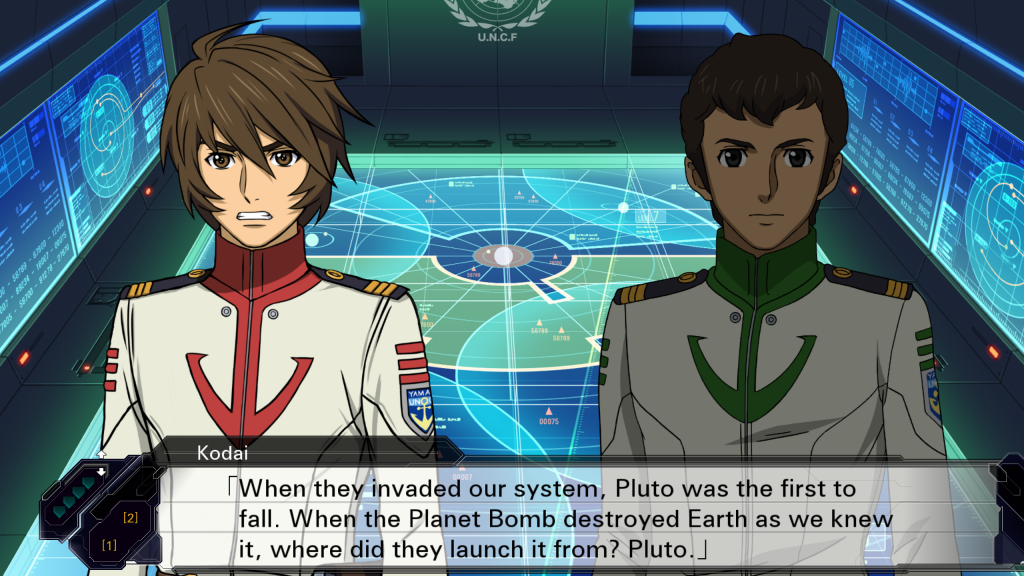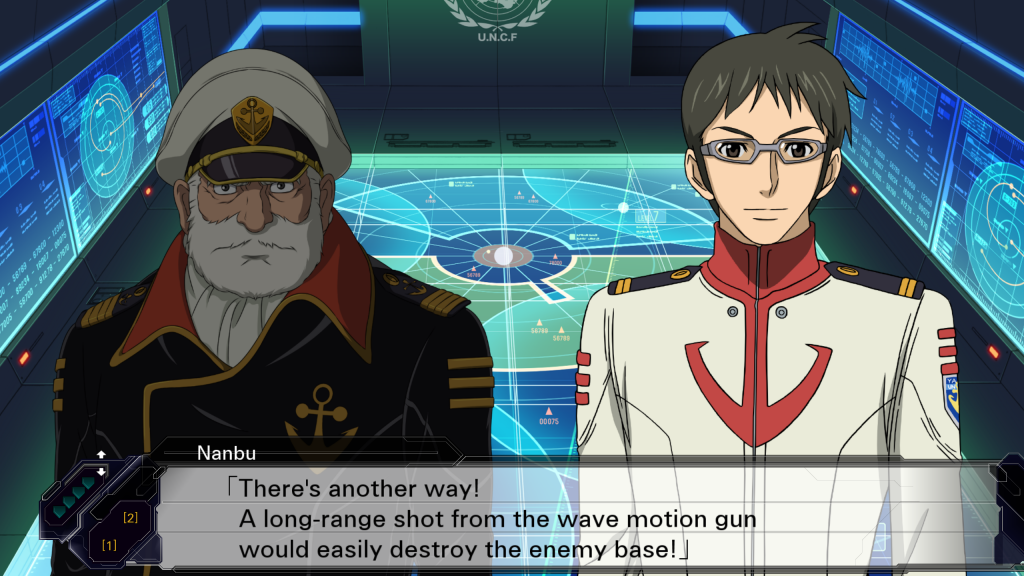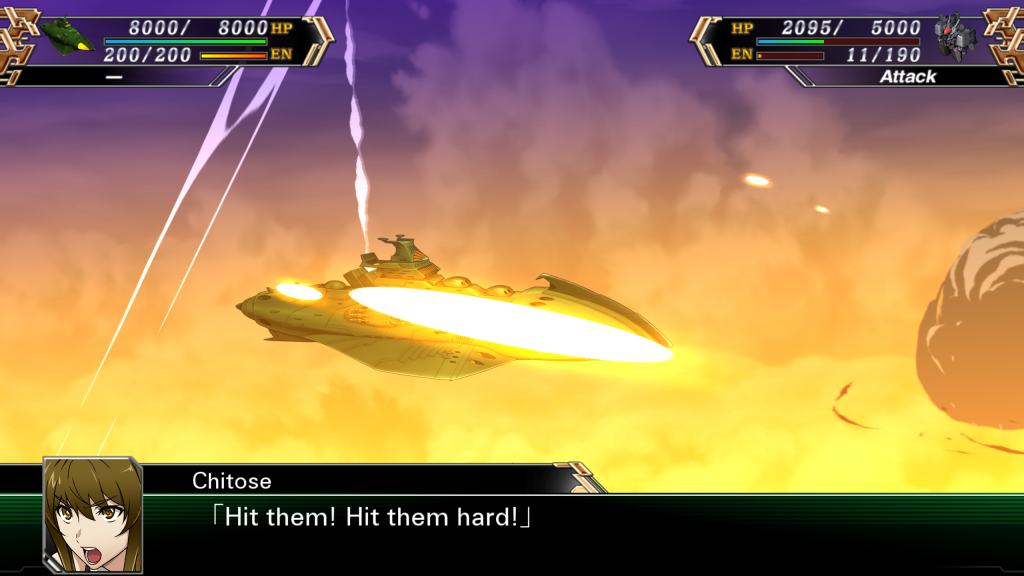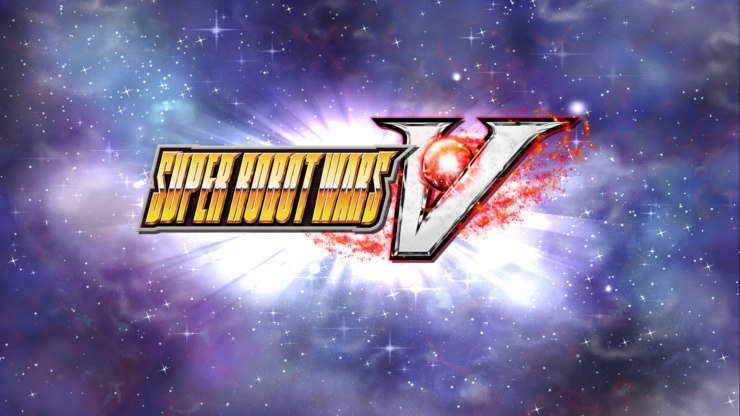Pros
- Fun gameplay for those who enjoy strategy and tactical RPGs
- Use of animation is reminiscent of artistic styles more common for systems with limited hardware (Playstation 1)
- Music is an interesting choice for this genre
- Mashup of your favorite mecha characters from anime like Neon Genesis Evangelion
- A lot of science fiction ideas mashed together in a wacky way
- Gundams, wormholes, battleships, alternate universes, aliens, and more!
Cons
- Writing could use some help—it’s bland, predictable, and needs some polish
- Playable map seems larger than it needs to be for the number of units available
- Hard mode seems a little too easy even though mode is scaled with SR points
Fans of Super Robot Wars rejoice! Super Robot Wars V keeps elements of what makes the game fun and modernizes the gameplay experience for video game enthusiasts today.
I remember being amazed at the SNES version when I was younger. I managed to get a hold of a friend’s copy of the game, and while I didn’t understand what was going on, the visuals, graphics, and music impressed me.
Gameplay
The best feature of Super Robot Wars V is the gameplay. There’s enough variation in pilots, skills, and equipment to allow you to really customize your mechs.

The basic gameplay is fairly standard for strategy and tactical RPGs. Since there are spaceships and mech units the game, weapons have a longer range. Some weapons even have a range of 8 units, allowing battles to end fairly quickly. One battleship even has a range of 10 units, allowing you to safely engage most mechs from far away.
Even on hard mode, I noticed that I was easily able to meet the extra mission objectives (for more money). Long weapon ranges and upgrades meant that my units rarely died, so there’s not much challenge there. My core units evaded most attacks, and when set to evade, very few hits connected.
One aspect of the game that I found a little confusing at first was the application of skills. You have to use Tactical Points to learn skills. Then you assign those skills to pilots. As you learn skills, you’ll unlock further, more powerful skills that you have to purchase and assign.
I imagine that the gameplay may get boring if there’s not much challenge in the game. About 25 chapters into the game, I’m still finding that battles are easy, and the only thing I’m looking forward to is more units or parts for my mechs. Still, the game is fun, with sometimes outrageous enemies making an appearance.
Another engaging aspect of the game is seeing characters from other anime or other series appear. I’m not familiar with many of these characters, having not played earlier games, but I’m fairly familiar with some of the anime references. For instance, Rei and Shinji from Neon Genesis Evangelion are playable characters. Macross fans will enjoy seeing those characters in the game.
Overall, stacking skill points on a few pilots and upgrading only a few mechs will allow you to easily win any battle. The only challenge would be to meet the bonus objective, but even that is easily attainable.
Graphics
Most veterans of tactical RPGs can forgive games that have graphics that don’t quite maximize modern graphics. As far as tactical RPGs go, the art style for Super Robot Wars V is fairly average for the genre, if not slightly worse. Unit models could have been updated to provide more detail.
The battle landscapes are fairly bland and boring. However, the animated cutscenes provide some nostalgic longing for games from the past. I have to remember that the game has to live up to the style and fun of its predecessors, but that doesn’t prohibit any updates to the unit models.
Below is an example of an error missed by an editor. What you also see is the battle map that you’ll play on. Notice how there’s an absence of terrain details, and the models are kind of generic and boring, with unique leaders marked more by a difference in color than appearance.

You’d be forgiven if you mistook Super Robot Wars V as a Playstation 2 game instead of a Playstation 4 game if you just glanced at the graphics.
Plot
Earth and its colonies in the solar system are under attack by the Gamillas, an empire that encompasses several civilizations in the galaxy. The Gamillans have devastated Earth with a Planet Bomb and are now attempting to exterminate humanity and take over the solar system.

The Yamato, Earth’s only battleship equipped with the experimental wave motion engine, is sent 168,000 light years to another civilization for help. The crew of the Yamato now face a perilous journey to save Earth.
There’s not much creativity to the plot. A fairly young crew is charged with saving the universe from an evil alien race. All the aliens are also humanoid, even human-like.
Most Japanese games of that era had fairly predictable plots involving some variation of this premise. It’s almost as though studios during the time filled out a template for video game plots.
There’s also very little attempt to discuss the science or technology throughout the game. The wave motion engine allows the Yamato to “jump” from place to place by creating a wormhole. More discerning players will likely notice glaring absence of descriptions and a seemingly liberal take on science fiction concepts.
Other issues regarding the game include the use of arbitrary technologies or devices to move the plot along. For instance, there’s the wave motion gun, parallel dimensions, wormholes, aliens, and …robotic mice? While these additions may be fun, there’s really no attempt to seamlessly integrate these elements into the story. They are just there.

I found myself just skimming through the discussions and scenes between battles. The writing felt very generic, and it was difficult to really like the characters. The game attempts to get you to feel for the characters through sympathy: so and so’s father died fighting the Gamillans during the war.
Maybe the most interesting character is Analyzer, the supercomputer on the Yamato. There’s a scene where Analyzer considers whether or not he can experience emotion. This kind of character development, though cliche, is more endearing than a crew member’s assertion that his or her brother died on a ship during the war.
There’s a lot going on with the game. There were definitely moments where I wondered if the plot devices were all written on scraps of paper, thrown into a hat, and then pulled out one by one to integrate into the story.
Conclusion
While I’ve heard of the Super Robot Wars series a long time ago, I was never really able to play it because it weren’t localized at the time. It’s a shame because Super Robot Wars V seems like it’s a more fun, wacky alternative to the venerable Front Mission series. I would have enjoyed it then, but the bland writing caused me to bypass all the dialogue in favor of just getting to the battles.
While you may not understand some of the anime or other Super Robot Wars references in the game, you’ll know enough of the plot to carry on. Just from a tactical RPG perspective, the game delivers a fairly average experience. But anime fans, especially fans of Macross, may find the game delivers a better experience.
This game is reminiscent of graphical styles prevalent during the Playstation 1 era of RPG games with the integration of short animated clips throughout the game. This sense of nostalgia adds that little bit more of charm to Super Robot Wars V.

One strong point is the music: there’s a jazzy, almost arcade-like feel to the music that matches well with the game. I almost get the feeling of Cowboy Bebop when the more jazzy pieces play.
Deficiencies like graphics and writing aside, the game still delivers a fun experience for people who enjoy what is now a fairly standard recipe for a Japanese tactical RPG game.



